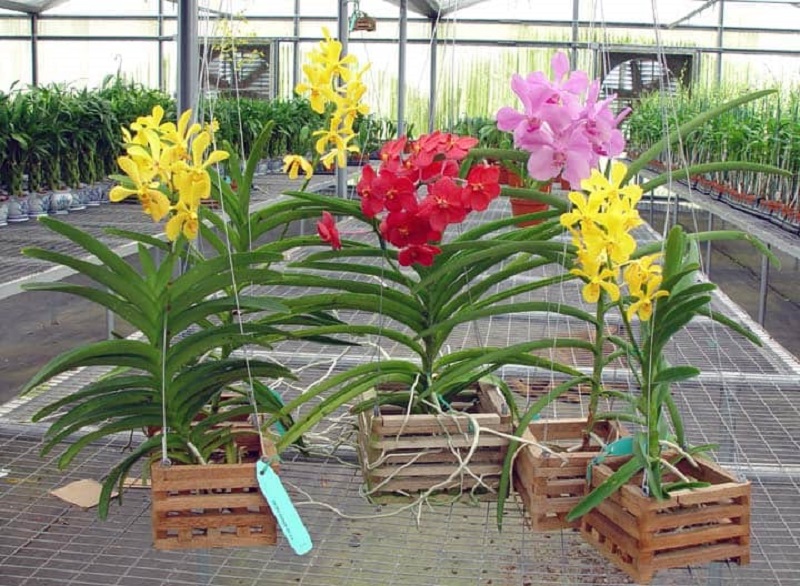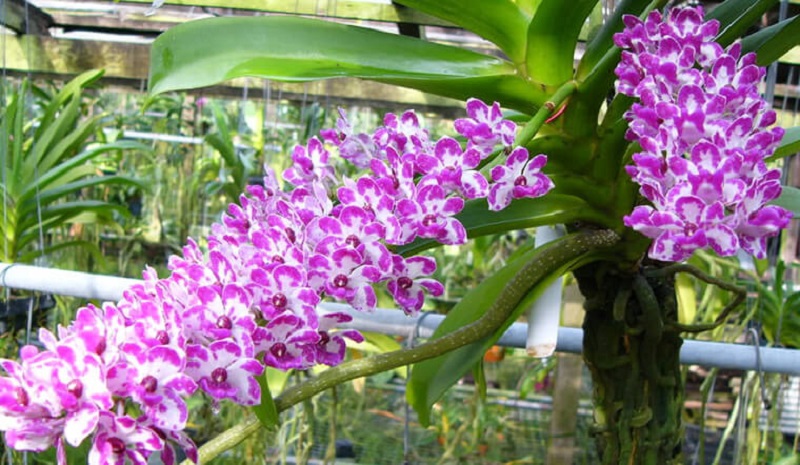Vanda orchids are renowned for their stunning beauty and vibrant colors, making them a favorite among orchid enthusiasts and horticulturists. These exotic flowers, native to Southeast Asia, are celebrated for their large, showy blooms and striking patterns. This comprehensive guide delves into the fascinating world of Vanda orchids, covering their taxonomy, key characteristics, natural habitat, care requirements, and more. Whether you’re an experienced orchid grower or a newcomer, this article will equip you with valuable insights to successfully cultivate and appreciate Vanda orchids.
Taxonomy and Classification of Vanda Orchids
Family and Subfamily
Vanda orchids belong to the Orchidaceae family, one of the largest and most diverse plant families in the world. Within this family, they are classified under the subfamily Epidendroideae.
Genus and Key Species
The Vanda genus includes several notable species, each known for its unique floral characteristics:
- Vanda sanderiana: Often recognized for its large, fragrant blooms.
- Vanda coerulea: Famous for its striking blue flowers.
- Vanda tricolor: Noted for its vibrant tricolor blooms.
These species contribute to the Vanda genus’s popularity due to their distinct and colorful flowers.

Morphology and Characteristics of Vanda Orchids
Pseudobulbs and Roots
Vanda orchids typically do not have pseudobulbs but possess a unique root system. They feature aerial roots that help in nutrient absorption and moisture collection from the air. These roots are crucial for the plant’s survival in its natural habitat.
Leaves
The leaves of Vanda orchids are narrow and linear, arranged in a rosette pattern. They are leathery and thick, adapted to retain moisture and endure varying light conditions.
Flowers
Vanda flowers are known for their large, showy blooms. The flower structure includes:
- Sepals and petals that create the flower’s shape.
- Lip (labellum) which often has intricate patterns and textures.
- Column which houses the reproductive organs.
Vanda orchids come in a variety of colors, including pink, purple, blue, and yellow. They typically bloom in a long-lasting, spectacular display that can span several weeks.
Natural Habitat of Vanda Orchids
Geographic Distribution
Vanda orchids are native to Southeast Asia, including countries such as Thailand, Malaysia, and the Philippines. They thrive in tropical and subtropical climates.
Environmental Conditions
In their natural habitats, Vanda orchids are found in environments such as:
- Rainforests
- Cloud forests
- Rocky outcrops
To mimic their natural habitat, Vanda orchids require specific conditions:
- Temperature: Typically between 24-30°C (75-85°F) during the day and slightly cooler at night.
- Light: Bright, indirect light is essential.
- Humidity: High humidity levels, ideally between 60-80%.
- Water: Regular watering with a well-draining medium that allows the roots to dry out slightly between waterings.
Cultivation and Care of Vanda Orchids
Potting and Medium
Vanda orchids are usually grown in hanging baskets or mounts rather than traditional pots. They thrive in a well-draining medium that often includes a mix of:
- Orchid bark
- Sphagnum moss
- Perlite
Watering
Consistent watering is crucial. Use distilled or rainwater to avoid mineral buildup. Ensure that the growing medium dries slightly between waterings to prevent root rot.
Fertilization
Apply a balanced orchid fertilizer every 2-4 weeks during the growing season. Follow the manufacturer’s instructions to avoid over-fertilization.
Light Requirements
Provide bright, indirect light or filtered sunlight. Direct sunlight can scorch the leaves, while insufficient light can hinder blooming.
Temperature and Humidity
Maintain temperatures between 24-30°C (75-85°F) during the day. Use a humidity tray or room humidifier to achieve the desired humidity levels if necessary.
Repotting
Repot Vanda orchids every 2-3 years or when they outgrow their growing medium. This helps refresh the medium and allows for healthy root growth.

Common Problems and Solutions for Vanda Orchids
Pests
Common pests that affect Vanda orchids include:
- Aphids
- Spider mites
- Scale insects
Treat pests with appropriate insecticides or organic solutions such as neem oil.
Diseases
Vanda orchids may encounter diseases such as:
- Root rot: Often caused by overwatering or poor drainage.
- Leaf spot: Can be due to fungal or bacterial infections.
Address these issues with proper watering techniques and fungicides if needed.
Environmental Issues
Problems like sunburn or etiolation (stretching) can occur due to inadequate light. Adjust light conditions and ensure consistent temperature and humidity to avoid these problems.
Propagation of Vanda Orchids
Methods of Propagation
Vanda orchids can be propagated through:
- Division: Splitting mature plants into smaller sections.
- Keiki Production: New plantlets that grow from the flower spike or leaf axils.
Timing and Conditions
Propagate during the growing season for optimal success. Ensure conditions are favorable for rooting and establishment.
Notable Hybrids and Varieties
Popular Hybrids
Some notable Vanda hybrids and varieties include:
- Vanda ‘Miss Joaquim’: Known as Singapore’s national flower with distinctive bright colors.
- Vanda ‘Robert’s Delight’: Features large, vibrant blooms.
Varieties with Unique Features
Explore varieties with exceptional traits such as unique fragrances or color patterns.
Cultural Significance of Vanda Orchids
Role in Horticulture
Vanda orchids are highly valued in horticulture for their stunning floral displays. They are frequently featured in floral arrangements and botanical exhibits, adding elegance and beauty.
Symbolism
In various cultures, Vanda orchids symbolize beauty and elegance, enhancing their appeal in cultural and decorative contexts.
Conclusion
Vanda orchids represent a remarkable example of the beauty and diversity within the Orchidaceae family. With their stunning flowers and specific care requirements, they offer both challenges and rewards to growers. By understanding their taxonomy, natural habitat, and care needs, you can successfully cultivate these magnificent plants. Whether you’re an experienced orchid enthusiast or a beginner, Vanda orchids provide a captivating opportunity to engage with one of nature’s most exquisite floral creations. Embrace the allure of Vanda orchids and enjoy the vibrant beauty they bring to any environment.
